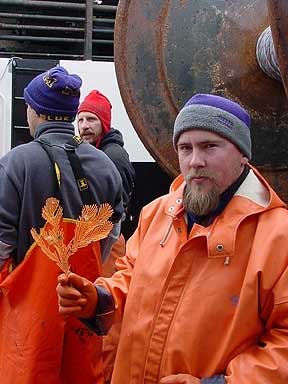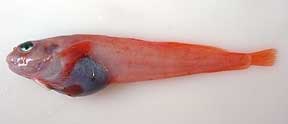 May 19, 2008
From the North Pacific and Bering Sea, they have newly described a flatfish, a skate, two eelpouts, and several snailfishes in the last decade. They have also unraveled some of the complex nomenclature and taxonomy of common species of rockfishes.
"I've been interested in fishes for as long as I can remember," said Stevenson. "As a kid, I spent a lot of time fishing the lakes and streams of Pennsylvania. I feel fortunate that I have been able to translate that interest into a career." "I knew in sixth grade that I wanted to be an ichthyologist," said Orr. "I only dreamed that I would have a job like this that allowed me to see and study fishes." Orr and Stevenson have also helped describe the ranges of already-known fish. They have recognized and documented several species not previously reported from Alaskan waters, including rockfishes, deepwater skates, slickheads, cuskeels, and snailfishes. "My job involves spending a lot of time at sea collecting and observing fishes. Back at the laboratory, I examine the specimens that we collect and compare them with other museum specimens, then I write about what I see. It's a lot like putting together the pieces of a puzzle," said Stevenson. They have recently helped write 'A Field Guide to Sharks, Skates, and Ratfish of Alaska,' published by NOAA's Sea Grant Office. They collaborated on the book with fellow Science Center scientist Jerry Hoff, who specializes in the reproductive ecology of skates, and international skate expert John McEachran of Texas A&M University. Orr and Stevenson have also authored many scientific reports and publications. Ongoing work includes another description of a new species of skate from the western Aleutian Islands. Like many of the species Orr and Stevenson have described, fishers and fishery scientists have probably encountered this 'new' skate in the past, but it took taxonomy-trained eyes to recognize it as an undescribed species. It also required careful detective work by Stevenson and Orr to find out it where it fit within the subgenus Arctoraja, a group of four species ranging across the North Pacific Ocean. After recognizing a potential new species, either in the field or in the laboratory, a taxonomist must inspect all available specimens very carefully, taking detailed notes on body proportions, bone structure, fin-ray counts, and other aspects that vary among different species of fishes. The potential new species must then be rigorously compared with similar forms, often using specimens collected from around the world and stored in museum collections in the U.S. and abroad. In order for a new species to be recognized by the scientific community, a taxonomist must publish an exhaustive description of the species in a scientific journal. This description lists examples of the species, known as "types", which are preserved and deposited in museum collections and made available for researchers around the world.
But it's not all the old-school taxonomy of bones and scales. Orr and Stevenson work closely with Alaska Fisheries Science Center geneticists Ingrid Spies in Seattle and Sharon Hawkins in Juneau, who have extensive expertise in modern DNA analytical techniques. Unlike the old days, when the only characteristics available to a taxonomist were the ones that could be seen, variations in protein and DNA structure can now be used as additional evidence in recognizing previously unknown species. Fish range broadly in the oceans, and fish taxonomists are active in the global research community, sharing data, specimens, and photographs to foster international consistency. Stevenson and Orr often find themselves working with the University of Washington researchers, and others around the world. Recently, Stevenson has been working on the systematic revision of the genus Bothrocara (a deepwater genus of elongate eelpouts, the most common of which is known as the twoline eelpout), a group of species that ranges throughout the cold, deep waters of the North Pacific, as well as the South Pacific and even the South Atlantic. He is collaborating with researchers at the South African Institute of Aquatic Biodiversity and at the National Science Museum in Tokyo, Japan. Working on a separate project to clarify the classification of the black eelpout has lead to contacts with the Zoological Institute of the Russian Academy of Sciences in St. Petersburg, Russia. Jay Orr's most recent work has been strongly influenced by his three month visit to Japan, working with researchers in Kyoto. While there, he was able to complete work to elevate an old name for a common rockfish newly recognized from Alaska, finalize studies on the new western Aleutians skate, and begin projects on new species of snailfishes. Each project called for collaboration with geneticists here and in Japan. Other new snailfishes will be arriving soon, as a publication of two new species with undergraduate intern Zach Baldwin is now in the works.
Source of News:
Publish A Letter in SitNews Read Letters/Opinions
|
|||

